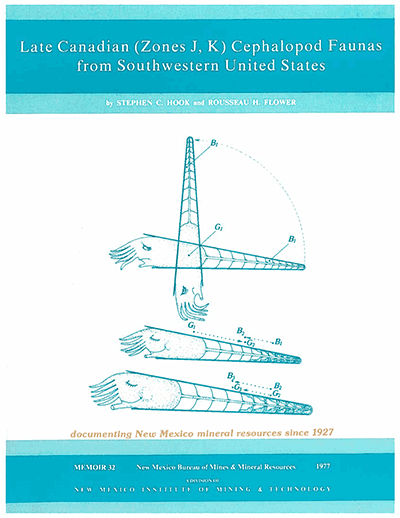
Memoir 32—Late Canadian (Zones J, K) cephalopod faunas from southwestern United States
By S. C. Hook and R. H. Flower, 1977, 102 pp., 1 table, 13 figs., 21 plates, 1 index.

Detailed study of cephalopod faunas from Wahwah Limestone of western Utah and the Florida Mountains Formation of west Texas and southwestern New Mexico. The Wahwah Limestone of western Utah and the Florida Mountains Formation of west Texas and southwestern NM have yielded the only large, well-preserved cephalopod faunas of latest Canadian age in North America. These faunas are completely Canadian in aspect and are dominated by the small orthocones belonging to the Ellemeroceratida and the Michelinoceratida. Surprisingly, the Tarphyceratida and Endoceratida, the dominant cephalopods of the Middle-Late Canadian, are minor faunal constituents in these faunas.
Analyses of more than 100 vertical thin sections of these orthocones revealed a morphological diversity previously unrecognized this early in the evolutionary history of the Cephalopoda. Complex patterns and combinations of cameral and siphonal deposits were observed in members of the Baltoceratidae, Protocycloceratidae, Michelinoceratidae, and Troedssonellidae. Three types of siphonal deposits (rods, annuli, and linings) and three types of cameral deposits (episeptal, hyposeptal, and mural) were observed in members of these families. The complexity of these patterns suggests a fairly long evolutionary history preceding the latest Canadian.
The derivation of the Troedssonellidae from the rod-bearing Baltoceratidae is further documented both stratigraphically and morphologically through the discovery of the new genus Veneficoceras, which is morphologically more similar to the rod-bearing Baltoceratidae than to the Troedssonellidae. The first North American representative of the genus Manchuroceras, previously known only from Manchuria and Australia and questionably from Siberia and Argentina, was discovered in the Florida Mountains Formation of west Texas. New criteria based on thin- and opaque-section analyses are established for recognition of ventral lobes in suture patterns.
Twenty-five new taxonomic names are proposed, including six new genera and 19 new species. The new genera are Amsleroceras, Rangeroceras, Veneficoceras, Bakeroceras, Wardoceras, and Enigmoceras. The new species are Amsleroceras gracile, Rangeroceras hintzei, Rhabdiferoceras planiseptatum, Veneficoceras susanae, Protocycloceras laswelli, P. rhabdiferum, Catoraphiceras ibexense, C. pearsonae, C. sinuatum, C. staceyae, Kyminoceras kottlowski, Rudolfoceras keadyi, R. russelli, Bakeroceras wahwahense, Manchuroceras lemonei, Michelinoceras floridaense, M. melleni, Wardoceras orygoforme, and Enigmoceras diaboli.
$11.50
Buy
Now
Also available as a free download.
Download
| File Name | Size | Last Modified |
|---|---|---|
| Memoir-32.pdf | 10.81 MB | 01/19/2021 09:40:06 AM |



